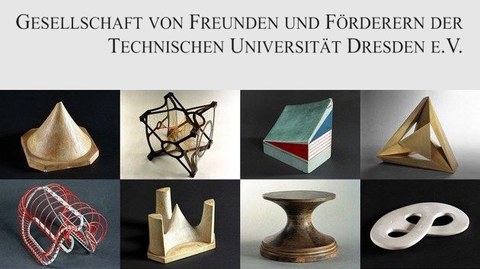Oct 18, 2018
Integration of material mathematical models in action-orientated teaching concepts for teacher training in mathematics
The AG Geometrische Modellierung und Visualisierung (working group geometric modeling and visualisation) and the professorship in didactics of mathematics want to develop and evaluate innovative and action-orientated teaching concepts through activation and development of the collection of mathematical models for the teaching students of mathematics.
Andrea Hoffkamp responsible for the teacher training and furthermore one of the scientific directors of the Erlebnisland Mathematik (adventure land mathematics), develops innovative teaching formats in her work and her focus on teaching lies in the connection between subject and teaching methodology. The learning workshop „Mathematik entdecken“ (discover mathematics), which Petra Woithe is responsible for, is dealing with teaching examples for problem and action-orientated working for math lessons. In such processes a collection of teaching materials and project ideas is formed.
The aim of the applicants (Hoffkamp, Lordick, Päßler, Woithe) is a decided use of the material mathematical models for the teaching and moreover an expansion of the collection. A systematic connection between object-related research and action-orientated didactics about the material models is supposed to be created. For learning and teaching mathematics the historical-genetic approach is of particular importance. In this way it can be clarified, that mathematics is a dynamic science with a long historic development, which is naturally reflected in the historic model collection.
The school lessons are often accused of a surplus of calculus („calculating without comprehension“). In the training of future teachers, we put a special emphasis on comprehension-orientated approaches. Our project is going to contribute especially to the courses of geometry, didactics of geometry, didactics of linear algebra and the learning workshop. For this purpose, an analysis of the existing models from a mathematical and historical-cultural point of view is planned. One aim is to motivate the students to create own models manually as well as digitally-virtually. Based on that, lesson drafts for the methodical revival of math lessons according to comprehension orientated approaches are supposed to originate.
At the same time an emancipated handling with digital media is supposed to be taught. Recently, it was announced by the Saxony Ministry of education and the arts, that a revise of the curriculum with a stronger and more meaningful involvement of digital media in schools is in the process of planning. DAMM as a digital research infrastructure with 3D visualisations, which is available online, and as such is a great test platform in this context. The expansion as a tool for teaching is one of the long-term goals of the applied project. Digital media had their origin in analogue approaches. A connection between the historical collection and digital methods of manufacturing and designing of models is especially valuable, because at the same time awareness and comprehension of the development of analogue media are supported. In relation to new models, a use of modern technology, like the 3D printer or working with a laser cutter, is especially appealing. Thereby special (mathematical) methods (e. g. coordinate geometry) move in focus of interest. For these contents a cooperation with the Makerspace of the SLUB is planned.
The project focusses on geometry. For multiple decades, we can observe in school education that the teaching of geometry with significant goals like the development of spatial imagination, concept formation processes, environment investigation and the discovery and problem orientated working is pushed back further and further. Our teaching students, who seldom have experienced the abundance of geometry in their own education, have to experience these goals all the more in their studies. Only then a positive retroactive effect on school education can happen. Because of this, the projects selection of topics has a special focus on the just mentioned goals of education. Thereby areas of the curriculum like volume calculation through disassembly and the display of figures are worked out action-based. Further contents, like conic sections, fractals, irrational relationships at cube decompositions are made accessible. This is supposed to lead to a comprehensive education under the awareness of the historical development and embedding in the area of geometry.

